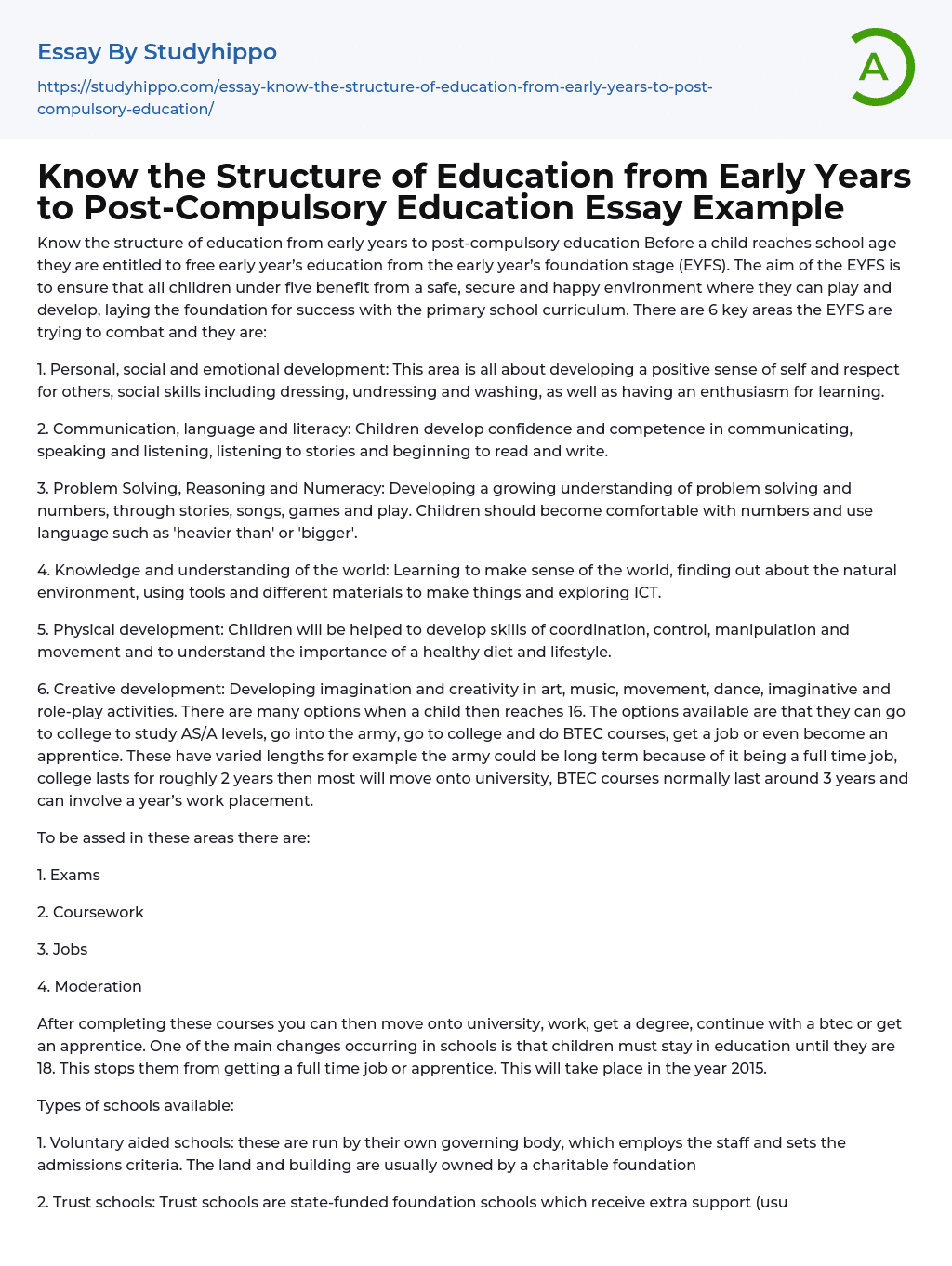

Know the Structure of Education from Early Years to Post-Compulsory Education Essay Example
Know the structure of education from early years to post-compulsory education Before a child reaches school age they are entitled to free early year’s education from the early year’s foundation stage (EYFS). The aim of the EYFS is to ensure that all children under five benefit from a safe, secure and happy environment where they can play and develop, laying the foundation for success with the primary school curriculum. There are 6 key areas the EYFS are trying to combat and they are:
1. Personal, social and emotional development: This area is all about developing a positive sense of self and respect for others, social skills including dressing, undressing and washing, as well as having an enthusiasm for learning.
2. Communication, language and literacy: Children develop confidence and competence in communicating, speaking and listening, listening to stories and beginning to read
...and write.
3. Problem Solving, Reasoning and Numeracy: Developing a growing understanding of problem solving and numbers, through stories, songs, games and play. Children should become comfortable with numbers and use language such as 'heavier than' or 'bigger'.
4. Knowledge and understanding of the world: Learning to make sense of the world, finding out about the natural environment, using tools and different materials to make things and exploring ICT.
5. Physical development: Children will be helped to develop skills of coordination, control, manipulation and movement and to understand the importance of a healthy diet and lifestyle.
6. Creative development: Developing imagination and creativity in art, music, movement, dance, imaginative and role-play activities. There are many options when a child then reaches 16. The options available are
that they can go to college to study AS/A levels, go into the army, go to college and do BTEC courses, get a job or even become an apprentice. These have varied lengths for example the army could be long term because of it being a full time job, college lasts for roughly 2 years then most will move onto university, BTEC courses normally last around 3 years and can involve a year’s work placement.
To be assed in these areas there are:
1. Exams
2. Coursework
3. Jobs
4. Moderation
After completing these courses you can then move onto university, work, get a degree, continue with a btec or get an apprentice. One of the main changes occurring in schools is that children must stay in education until they are 18. This stops them from getting a full time job or apprentice. This will take place in the year 2015.
Types of schools available:
1. Voluntary aided schools: these are run by their own governing body, which employs the staff and sets the admissions criteria. The land and building are usually owned by a charitable foundation
2. Trust schools: Trust schools are state-funded foundation schools which receive extra support (usually non-monetary) from a charitable trust made up of partners working together for the benefit of the school.
3. Specialist schools: they follow the national curriculum nut the schools will focus on one particular are for example sport, technology or music
4. Academies: is a school directly funded by central government (specifically, the Department for Education) and independent of direct control by the local
government in England.
5. Faith schools: these are mainly religious but anyone can apply for a place. They are run by governing bodies who employ staff and set the admissions criteria like foundation schools
6. Foundation schools: state-funded school in which the governing body has greater freedom in the running of the school than in community schools. Funded directly by the government
7. Grammar schools: independent schools in which parents pay fees for their children to attend. They set their own curriculum and admissions policy but are regularly monitored by Ofsted
8. Community schools: a type of state-funded school in which the local education authority employs the school's staff, is responsible for the school's admissions and owns the school's estate
9. Independent school: independent in its finances and governance; it is not dependent upon national or local government for financing its operations, nor reliant on taxpayer contributions. It is governed by a board of directors that is elected by an independent means and a system of governance that ensures its independent operation.
- Academia essays
- Higher Education essays
- Language Learning essays
- Studying Business essays
- Education System essays
- Study essays
- First Day of School essays
- Scholarship essays
- Pedagogy essays
- Curriculum essays
- Coursework essays
- Studying Abroad essays
- Philosophy of Education essays
- Purpose of Education essays
- Brainstorming essays
- Educational Goals essays
- Importance Of College Education essays
- Brown V Board of Education essays
- The Importance Of Higher Education essays
- Online Education Vs Traditional Education essays
- Academic And Career Goals essays
- Academic Integrity essays
- Brown Vs Board Of Education essays
- Distance learning essays
- Technology in Education essays
- Vocabulary essays
- Writing Experience essays
- Importance of Education essays
- Early Childhood Education essays
- Academic Degree essays
- Academic Dishonesty essays
- School Uniform essays
- Academic writing essays
- Cheating essays
- Bachelor's Degree essays
- MBA essays
- College Life essays
- Grade essays
- Diploma essays
- Phonology essays
- Sentence essays
- Filipino Language essays
- Pragmatics essays
- Millennium Development Goals essays
- History Of Education essays
- Graduate School essays
- Middle School essays
- School essays
- Special Education essays
- University essays



